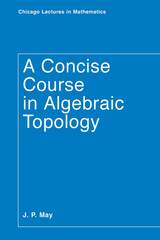
J. Peter May's approach reflects the enormous internal developments within algebraic topology over the past several decades, most of which are largely unknown to mathematicians in other fields. But he also retains the classical presentations of various topics where appropriate. Most chapters end with problems that further explore and refine the concepts presented. The final four chapters provide sketches of substantial areas of algebraic topology that are normally omitted from introductory texts, and the book concludes with a list of suggested readings for those interested in delving further into the field.
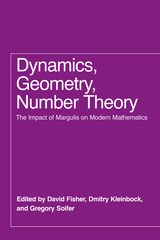
This edited collection highlights the foundations and evolution of research by widely influential Fields Medalist Gregory Margulis. Margulis is unusual in the degree to which his solutions to particular problems have opened new vistas of mathematics; his ideas were central, for example, to developments that led to the recent Fields Medals of Elon Lindenstrauss and Maryam Mirzhakhani. Dynamics, Geometry, Number Theory introduces these areas, their development, their use in current research, and the connections between them. Divided into four broad sections—“Arithmeticity, Superrigidity, Normal Subgroups”; “Discrete Subgroups”; “Expanders, Representations, Spectral Theory”; and “Homogeneous Dynamics”—the chapters have all been written by the foremost experts on each topic with a view to making them accessible both to graduate students and to experts in other parts of mathematics. This was no simple feat: Margulis’s work stands out in part because of its depth, but also because it brings together ideas from different areas of mathematics. Few can be experts in all of these fields, and this diversity of ideas can make it challenging to enter Margulis’s area of research. Dynamics, Geometry, Number Theory provides one remedy to that challenge.
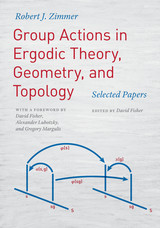
In addition to the selected papers themselves, this volume opens with a foreword by David Fisher, Alexander Lubotzky, and Gregory Margulis, as well as a substantial introductory essay by Zimmer recounting the course of his career in mathematics. The volume closes with an afterword by Fisher on the most recent developments around the Zimmer program.
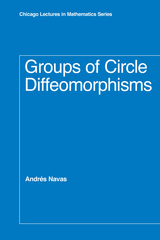
In recent years scholars from a variety of branches of mathematics have made several significant developments in the theory of group actions. Groups of Circle Diffeomorphisms systematically explores group actions on the simplest closed manifold, the circle. As the group of circle diffeomorphisms is an important subject in modern mathematics, this book will be of interest to those doing research in group theory, dynamical systems, low dimensional geometry and topology, and foliation theory. The book is mostly self-contained and also includes numerous complementary exercises, making it an excellent textbook for undergraduate and graduate students.

Because Lie groups form a staple of most mathematics graduate students' diets, this work on exceptional Lie groups should appeal to many of them, as well as to researchers of algebraic geometry and topology.
J. Frank Adams was Lowndean professor of astronomy and geometry at the University of Cambridge. The University of Chicago Press published his Lectures on Lie Groups and has reprinted his Stable Homotopy and Generalized Homology.
Chicago Lectures in Mathematics Series
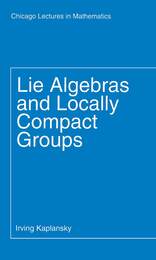
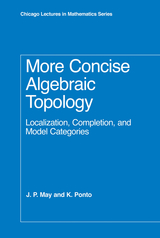
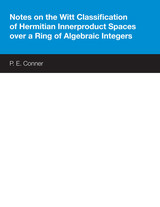

Boldly original and boundary defining, The Topological Imagination clears a space for an intellectual encounter with the shape of human imagining. Joining two commonly opposed domains, literature and mathematics, Angus Fletcher maps the imagination’s ever-ramifying contours and dimensions, and along the way compels us to re-envision our human existence on the most unusual sphere ever imagined, Earth.
Words and numbers are the twin powers that create value in our world. Poetry and other forms of creative literature stretch our ability to evaluate through the use of metaphors. In this sense, the literary imagination aligns with topology, the branch of mathematics that studies shape and space. Topology grasps the quality of geometries rather than their quantifiable measurements. It envisions how shapes can be bent, twisted, or stretched without losing contact with their original forms—one of the discoveries of the eighteenth-century mathematician Leonhard Euler, whose Polyhedron Theorem demonstrated how shapes preserve “permanence in change,” like an aging though familiar face.
The mysterious dimensionality of our existence, Fletcher says, is connected to our inhabiting a world that also inhabits us. Theories of cyclical history reflect circulatory biological patterns; the day-night cycle shapes our adaptive, emergent patterns of thought; the topology of islands shapes the evolution of evolutionary theory. Connecting literature, philosophy, mathematics, and science, The Topological Imagination is an urgent and transformative work, and a profound invitation to thought.
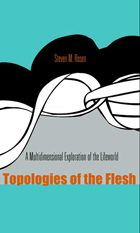
The concept of “flesh” in philosophical terms derives from the writings of Maurice Merleau-Ponty. This was the word he used to name the concrete realm of sentient bodies and life processes that has been eclipsed by the abstractions of science, technology, and modern culture. Topology, to conventional understanding, is the branch of mathematics that concerns itself with the properties of geometric figures that stay the same when the figures are stretched or deformed.
Topologies of the Flesh is an original blend of continental thought and mathematical imagination. Steven M. Rosen opens up a new area of philosophical inquiry: topological phenomenology. Through his unique application of qualitative mathematics, he extends the approaches of Merleau-Ponty and Heidegger so as to offer a detailed exploration of previously uncharted dimensions of human experience and the natural world.
Rosen’s unprecedented marriage of topology and phenomenology is motivated by the desire to help overcome the pervasive dualism of contemporary philosophy and Western culture at large. To carry this to completion, he must address his own dualistic stance as author. Challenging the author’s traditional posture of detachment and anonymity, Rosen makes his presence vividly felt in his final chapter, and his philosophical analysis is transformed into a living reality.
READERS
Browse our collection.
PUBLISHERS
See BiblioVault's publisher services.
STUDENT SERVICES
Files for college accessibility offices.
UChicago Accessibility Resources
home | accessibility | search | about | contact us
BiblioVault ® 2001 - 2024
The University of Chicago Press









